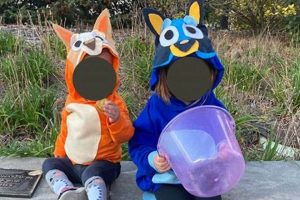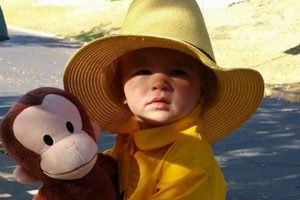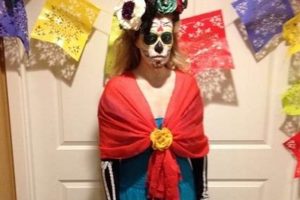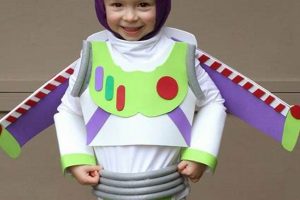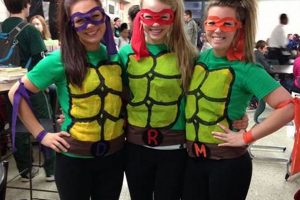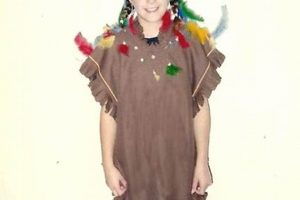A homemade undead ensemble allows individuals to creatively express themselves through the construction of unique Halloween or cosplay attire. This approach to crafting a macabre appearance typically involves repurposing existing clothing and utilizing readily available materials to simulate decay, injury, and general dishevelment associated with fictional reanimated corpses.
The advantages of creating a personalized ghoul getup include cost-effectiveness, as it circumvents the expense of commercially produced outfits. Moreover, it provides a canvas for individual artistic vision, enabling the wearer to tailor the level of gore, style of decomposition, and overall aesthetic to match personal preferences. Historically, homemade costumes have fostered a sense of community and resourcefulness, transforming ordinary items into objects of imaginative expression.
The subsequent sections will detail specific techniques for achieving realistic deterioration effects, selecting appropriate clothing for modification, and applying makeup to complete the transformation. Various methods will be explored, providing options for different skill levels and budgetary constraints.
Tips for Constructing a Convincing Undead Disguise
The creation of a compelling decayed apparition requires meticulous attention to detail. Focus should be given to crafting an ensemble that is both visually striking and believably deteriorated. The following guidelines offer strategies for maximizing impact.
Tip 1: Fabric Selection is Paramount: Prioritize garments constructed from durable materials that can withstand distressing techniques. Natural fibers, such as cotton or linen, often respond favorably to tearing, staining, and manipulation.
Tip 2: Emphasize Asymmetry: Authentic decay rarely occurs uniformly. Introduce uneven tears, rips, and abrasions to simulate the haphazard nature of decomposition and trauma.
Tip 3: Layering Enhances Depth: Combine multiple articles of clothing to create visual complexity and provide opportunities for revealing simulated wounds and exposed tissue.
Tip 4: Strategic Staining is Essential: Utilize fabric dyes, diluted acrylic paints, or even coffee grounds to impart a grimy, aged appearance. Focus on areas prone to staining, such as the knees, elbows, and chest.
Tip 5: Incorporate Texture: Apply diluted latex or liquid bandages to create raised, textured surfaces that mimic decaying flesh or scar tissue. Allow these applications to dry partially before manipulating them to create a more organic look.
Tip 6: Accessorize Appropriately: Consider adding props such as artificial bones, blood capsules, or simulated weaponry to enhance the overall impact of the presentation. Ensure that any props are safely handled and do not pose a risk to the wearer or others.
Tip 7: Footwear Considerations: Neglecting the shoes undermines the overall effect. Apply similar distressing techniques to footwear, or opt for worn, damaged shoes that complement the rest of the attire. Avoid pristine or obviously modern footwear.
Adhering to these recommendations can significantly elevate the realism of a DIY zombie costume. The goal is to create a believable visual narrative of decay and reanimation through careful planning and execution.
The succeeding portion of this presentation will focus on makeup application techniques to further refine the ghastly manifestation.
1. Torn clothing texture
The incorporation of torn clothing texture is a critical component in achieving a convincing undead aesthetic within the realm of do-it-yourself zombie ensembles. The intentional manipulation and degradation of fabric surfaces serves to visually communicate decay, damage, and the passage of time following zombification.
- Simulating Physical Trauma
Tears, rips, and abrasions in clothing directly imply physical encounters and struggles, integral to the zombie narrative. Strategically placed tears can suggest wounds inflicted during the initial infection or subsequent conflicts. For example, jagged tears around the shoulders might indicate bites or claw marks, while rips along the legs could signify encounters with rough terrain. This visual storytelling contributes to the overall believability of the undead character.
- Establishing a Timeline of Decay
The extent and nature of the damage to clothing can imply the duration since zombification. Fresh tears may suggest a relatively recent transformation, while heavily frayed and tattered garments could indicate a prolonged period of undeath. The presence of dirt, grime, and discoloration further reinforces this timeline, conveying the impression of neglect and exposure to the elements.
- Enhancing Visual Interest and Depth
Variations in texture create visual interest and depth, preventing the costume from appearing flat or contrived. Employing different tearing techniques, such as straight cuts, jagged rips, and frayed edges, adds complexity to the overall look. Layering torn garments further enhances this effect, allowing for glimpses of underlying fabrics and simulated wounds.
- Distancing from the Mundane
Torn clothing textures effectively distance the character from the realm of the living and the ordinary. The damaged and degraded state of the garments serves as a visual cue, immediately signaling the wearer’s transformed status. This is particularly important in scenarios where makeup and prosthetics may be less elaborate; the clothing itself becomes a primary indicator of the character’s undead nature.
In conclusion, the intentional application of torn clothing textures is not merely an aesthetic choice within the realm of DIY zombie costumes; it is a deliberate act of visual storytelling that enhances believability, establishes a timeline of decay, and effectively distances the character from the ordinary. Careful consideration of the type, placement, and extent of fabric damage is essential for achieving a truly convincing undead portrayal.
2. Realistic wound simulation
Realistic wound simulation is a pivotal aspect of DIY zombie costume creation, significantly impacting the overall believability and visual impact of the undead character. The effective representation of injuries, decay, and trauma is paramount in conveying the grotesque transformation from living to undead.
- Material Selection for Verisimilitude
The choice of materials directly influences the realism of simulated wounds. Latex, silicone, and gelatin offer varying degrees of flexibility and texture, allowing for the creation of wounds that appear to stretch and distort naturally. Artificial blood, available in diverse shades and viscosities, can simulate both fresh and coagulated blood, a
dding depth and detail. Household items, such as corn syrup and food coloring, can also be employed for cost-effective alternatives. The strategic application of these materials is crucial for achieving a convincing effect. - Sculpting and Molding Techniques
Creating realistic wounds often necessitates sculpting and molding techniques. Liquid latex can be layered onto the skin and sculpted while drying to create raised, irregular surfaces that mimic swollen tissue or scarification. Molds, constructed from clay or plaster, can be used to cast complex wound shapes, such as exposed bone or protruding organs. The careful blending of these elements with the wearer’s skin is essential for seamless integration and a more believable appearance.
- Coloration and Shading for Depth
Proper coloration and shading techniques enhance the depth and dimension of simulated wounds. Utilizing a range of colors, from deep reds and purples to sickly greens and browns, can replicate the discoloration associated with bruising, infection, and decay. Applying highlights and shadows with makeup brushes can further accentuate the contours of the wound, creating a more three-dimensional effect. The use of stippling sponges can impart a textured appearance, mimicking the rough surface of damaged tissue.
- Placement and Contextual Consistency
The placement of wounds should be contextually consistent with the zombie’s supposed history and cause of death. Wounds on the neck might suggest strangulation or a bite, while gashes on the limbs could indicate struggles with other survivors. The size, shape, and severity of the wounds should align with the overall narrative of the costume. Random or illogical placement can detract from the realism and diminish the impact of the undead character.
The successful integration of these elements elevates the DIY zombie costume from a simple disguise to a compelling representation of the undead. Meticulous attention to detail, thoughtful material selection, and skillful application techniques are paramount in achieving a truly convincing and horrifying effect.
3. Grisly color palette
The selection of a grisly color palette is paramount in the creation of an effective homemade undead ensemble. This palette directly contributes to the visual communication of decay, disease, and the unnatural state of reanimation associated with the zombie archetype. The specific colors employed serve as visual cues, signaling to the observer the character’s transformation and separation from the living.
The foundation of such a palette typically consists of muted and desaturated tones. Greens, yellows, browns, and purples are often utilized to mimic the discoloration of decomposing flesh. These colors can be applied to both clothing and makeup, creating a cohesive and unsettling visual effect. For example, applying a sickly green foundation to the face, coupled with purple shadows around the eyes, can effectively simulate the pallor of death. Similarly, staining fabric with diluted browns and greens can replicate the grime and decay of clothing exposed to the elements. The strategic use of red, representing blood, provides a stark contrast and further reinforces the violent nature of the transformation. However, an overreliance on vibrant or unrealistic colors can detract from the overall believability. The palette should evoke a sense of sickness and decay, not a cartoonish or theatrical representation. Consider the color of rotting meat, decaying leaves, or festering wounds for inspiration.
In summary, a carefully curated grisly color palette is not merely an aesthetic choice but a fundamental element in conveying the undead nature of the character in a DIY zombie costume. The strategic application of muted and desaturated tones, coupled with the judicious use of contrasting colors, effectively communicates decay, disease, and the grotesque transformation from life to undeath. This attention to detail significantly enhances the overall impact and believability of the finished ensemble.
4. Distressed footwear choice
Footwear selection plays a crucial role in completing a credible undead persona within the context of a do-it-yourself zombie ensemble. The condition and style of the footwear contribute significantly to the overall narrative of decay and neglect, enhancing the believability of the costume.
- Conveying Environmental Exposure
Footwear that exhibits signs of wear and tear effectively communicates the zombie’s prolonged exposure to the elements. Scuffed surfaces, torn fabric, and embedded dirt suggest extended periods of wandering through various terrains, reinforcing the idea of a reanimated corpse subjected to the harshness of the environment. Examples include boots with cracked soles, sneakers with ripped canvas, or shoes coated in mud and grime. Such details underscore the zombie’s detachment from civilized society and its immersion in a world of decay.
- Reflecting Pre-Mortem Identity
The type of footwear can provide subtle clues about the zombie’s former life. A tattered work boot might suggest a manual laborer, while a torn ballet slipper could hint at a dancer. Maintaining some semblance of the original footwear, albeit in a distressed state, adds depth to the character and allows for a more nuanced portrayal of the undead. This element of backstory, conveyed through the footwear, enriches the overall narrative of the costume.
- Enhancing Mobility and Movement
The choice of footwear should also consider the desired movement and gait of the zombie character. Ill-fitting or damaged shoes can influence the wearer’s stride, contributing to the shuffling and unsteady movements commonly associated with the undead. Footwear that restricts movement or appears uncomfortable adds to the visual impression of decay and impaired motor function. For example, wearing shoes that are slightly too large or have uneven soles can subtly alter the wearer’s posture and gait, enhancing the zombie-like appearance.
- Complementing the Overall Aesthetic
The footwear should harmonize with the overall style and theme of the zombie costume. A ragged business suit paired with pristine athletic shoes would create a jarring and incongruous effect. Selecting footwear that complements the decay and disrepair of the clothing and makeup is essential for a cohesive and convincing portrayal. Distressing techniques, such as staining, tearing, and scuffing, can be applied to new or secondhand footwear to achieve the desired level of deterioration.
The selection of distressed footwear, therefore, is not merely an afterthought but an integral component of a well-executed DIY zombie costume. The footwear contributes to the narrative, influences the wearer’s movement, and complements the overall aesthetic, thereby enhancing the believability and impact of the undead character.
5. Appropriate accessory selection
Accessory selection significantly influences the narrative and impact of a homemade undead ensemble. T
hese supplementary items extend beyond mere ornamentation; they function as storytelling devices, enriching the portrayal of the reanimated character.
- Weaponry and Tools of the Undead Apocalypse
Simulated weapons or tools contribute to the post-apocalyptic context of the zombie scenario. A bloodied, rusted crowbar implies survival and conflict, while a tattered medical kit suggests a former caregiver now among the infected. These accessories communicate the character’s role within the fictional world, adding depth and realism. A haphazardly carried fire axe or a length of chain can imply different aspects of survival in a zombie-infested environment.
- Personal Effects as Remnants of Humanity
Accessories reflecting the zombie’s pre-mortem life create a poignant contrast between their past humanity and current state. A torn photograph, a worn wedding ring, or a child’s toy evokes a sense of loss and the lingering vestiges of their former identity. Such items can be strategically placed or attached to the costume, serving as visual reminders of the character’s tragic transformation. A half-destroyed business card or a faded ID badge can provide hints about the zombie’s past profession.
- Gore and Body Part Augmentation
Artificial gore and simulated body parts amplify the visual horror and reinforce the undead nature of the character. Prosthetic limbs, exposed bones, or decaying organs contribute to the grotesque aesthetic and enhance the overall shock value of the costume. These accessories require careful crafting and placement to ensure a believable and unsettling effect. Artificial entrails or exposed rib cages can significantly amplify the visual impact of the costume.
- Practical Considerations for Safety and Functionality
While aesthetic concerns are paramount, accessory selection must also prioritize safety and practicality. Props should be lightweight, durable, and free of sharp edges or hazardous materials. Ensure that accessories do not impede movement or vision, potentially causing accidents or discomfort. Simulated weapons should be clearly identifiable as non-functional, especially in public settings. The wearer’s comfort and safety should remain a primary concern throughout the design and implementation of the costume.
The considered integration of accessories is not merely about adornment; it is a strategic enhancement that enriches the narrative, amplifies the visual impact, and reinforces the undead essence of the homemade zombie costume. By carefully selecting and incorporating these supplementary elements, the individual transforms a simple disguise into a compelling and immersive character portrayal.
Frequently Asked Questions
This section addresses common inquiries and provides clarification regarding the construction of homemade undead ensembles.
Question 1: Is specialized expertise required to construct a convincing decaying corpse attire?
No specific expertise is mandated, though familiarity with basic crafting techniques, such as fabric manipulation and makeup application, is beneficial. Resourcefulness and a willingness to experiment are paramount.
Question 2: What is the typical expenditure associated with crafting a DIY zombie costume?
Expenditure varies widely depending on the complexity of the desired effect and the materials utilized. Repurposing existing clothing and utilizing readily available household items can significantly reduce costs.
Question 3: How can realistic wound simulations be achieved using readily accessible materials?
Liquid latex, readily available from costume shops, can be applied to the skin in layers to create raised surfaces. These can be further enhanced with makeup and artificial blood to simulate open wounds or decaying flesh.
Question 4: What are the recommended methods for distressing clothing to achieve a tattered and worn appearance?
Ripping, tearing, and sanding fabric surfaces are effective techniques for creating a distressed look. Staining with diluted dyes, coffee grounds, or acrylic paints can further enhance the impression of decay and neglect.
Question 5: How should makeup be applied to achieve a convincingly undead complexion?
A pale or gray foundation serves as a base. Dark shadows around the eyes and cheekbones create a gaunt appearance. Green and purple hues can be applied to simulate bruising and discoloration. The use of stippling sponges adds texture.
Question 6: Are there any safety precautions that should be observed when constructing and wearing a zombie costume?
Materials should be non-toxic and hypoallergenic to prevent skin irritation. Simulated weapons should be lightweight and clearly identifiable as non-functional. Ensure that the costume does not impede vision or movement, reducing the risk of accidents.
In summary, the creation of a successful DIY zombie costume hinges on careful planning, resourceful utilization of materials, and a meticulous attention to detail. Safety considerations should always be prioritized.
The next section will delve into inspirational sources for zombie costume design.
DIY Zombie Costume
The preceding discourse has illuminated the multifaceted aspects of constructing a compelling homemade undead ensemble. Key elements explored encompassed fabric manipulation techniques, realistic wound simulation protocols, the strategic deployment of a grisly color palette, informed footwear selection, and the considered integration of supplementary accessories. The successful execution of these components, when harmonized, culminates in a visually striking and narratively rich portrayal of the reanimated dead.
Mastering these techniques enables the creation of individualized and cost-effective representations of the zombie archetype. Further exploration and experimentation will undoubtedly lead to continued refinement of these methods, expanding the creative possibilities within the realm of macabre costuming. The construction of a DIY zombie costume, therefore, stands as a testament to human ingenuity and a fascination with the darker aspects of imagination.


